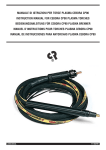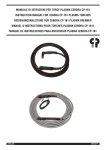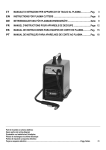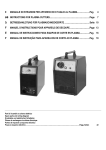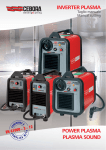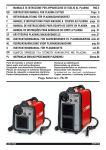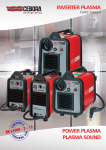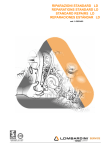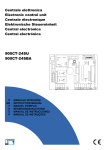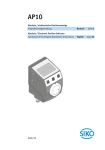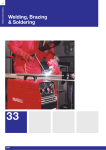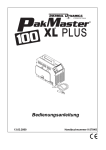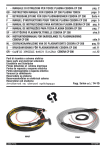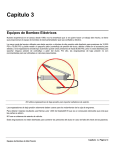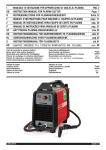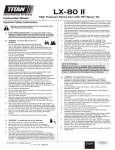Download I -MANUALE DI ISTRUZIONI PER TORCE PLASMA
Transcript
I -MANUALE DI ISTRUZIONI PER TORCE PLASMA CEBORA CP 41C pag. 2 GB -INSTRUCTION MANUAL FOR CEBORA CP41C PLASMA TORCH page 4 D -BETRIEBSANLEITUNG FÜR DEN PLASMABRENNER CEBORA CP41C Seite 6 F -MANUEL D'INSTRUCTIONS POUR TORCHE PLASMA CEBORA CP41C page 8 E -MANUAL DE INSTRUCCIONES PARA ANTORCHA PLASMA CEBORA CP41C pag. 10 Parti di ricambio Spare parts Ersatzteile Pièces détachées Partes de repuesto Pag. 12 3.300.308 12/11/11 MANUALE DI ISTRUZIONI PER TORCIA PLASMA CEBORA CP-41C Prima di utilizzare questa torcia, leggere attentamente il presente manuale. Questa torcia è costruita in stretta osservanza delle prescrizioni in materia di sicurezza contenute nella norma IEC 60974-7. In osservanza a quanto prescritto da tali norme, la CEBORA SPA dichiara che questa torcia si deve utilizzare solo con generatori CEBORA. I ricambi ed i particolari di consumo sono parti integrali della torcia, pertanto la CEBORA considera manomissione della stessa l'utilizzo di particolari NON ORIGINALI e declina quindi, in conformità allo spirito della norma stessa, ogni responsabilità, comprese quelle previste dal contratto di garanzia. Qualsiasi uso non descritto, è da considerarsi NON AMMESSO. La messa in funzione, l'uso e la manutenzione vanno esercitati da personale qualificato. Attenersi inoltre alle norme antinfortunistiche vigenti. 1 - PREMESSA Questa torcia, progettata per il taglio di materiali elettroconduttori (metalli e leghe) mediante il procedimento ad arco plasma, utilizza aria come gas plasma e di raffreddamento. Il taglio ad "ARCO PLASMA" avviene per l'alta temperatura generata da un arco elettrico concentrato, quindi possono innescarsi situazioni altamente pericolose. E' indispensabile pertanto tenere nella massima considerazione il capitolo riguardante le PRECAUZIONI DI SICUREZZA descritto nel manuale del generatore al quale è collegata la torcia. Non è previsto, inoltre, che le torce debbano funzionare sotto la pioggia o neve o in condizioni equivalenti. Il presente manuale deve essere conservato con cura, in un luogo noto all'operatore. Dovrà essere consultato ogni volta che vi sono dubbi, dovrà seguire tutta la vita operativa della macchina e dovrà essere impiegato per l'ordinazione delle parti di ricambio. 2 DATI TECNICI Corrente di taglio massima I2 = 40A D.C. Fattore di servizio X = 35% con I2 = 40A. Fattore di servizio X = 60% con I2 = 20A. Tensione di lavoro U2 = 90V (ugello a contatto con il pezzo). Pressione di lavoro con cavo: 4m = 3,5 bar (0,35 MPa) Portata aria totale = 60 litri/minuto. 3 SICUREZZA Questa torcia è provvista di una sicurezza elettrica, posta sul corpo torcia, per evitare che vi siano tensioni pericolose quando si sostituiscono l'ugello, l'elettrodo, il diffusore o il portaugello. E’ conforme alla norma IEC 609747 la quale prescrive che l'ugello posto verticalmente su un piano orizzontale, essendo parte in tensione, non possa essere toccato dal dito di prova convenzionale le cui caratteristiche sono indicate dalla norma stessa. 2 4 MANUTENZIONE TORCIA Togliere sempre l'alimentazione alla macchina prima di ogni intervento che deve essere eseguito da personale qualificato. 4.1 SOSTITUZIONE DELLE PARTI DI CONSUMO (FIG. 1-2) I particolari soggetti ad usura sono l'elettrodo G, il diffusore F e l'ugello E e devono essere sostituiti dopo aver svitato il portaugello D. L'elettrodo G deve essere sostituito quando presenta un cratere al centro profondo circa 1 mm. L'ugello E va sostituito quando presenta il foro centrale rovinato o allargato rispetto a quello del particolare nuovo. Una ritardata sostituzione dell'elettrodo e dell'ugello provoca un eccessivo riscaldamento delle parti, tale da pregiudicare la durata del diffusore F. L’ elettrodo deve essere svitato o avvitato al corpo torcia mediante l’ apposita chiave. Il diffusore , l’elettrodo e l’ugello debbono essere montati F nell’ordine indicato in figura. Assicurarsi che dopo la sostituzione il portaugello D G sia stretto a sufficienza. ATTENZIONE! Avvitare il portaugello D sul corpo torE cia solo con l'elettrodo G, il diffusore F e l'ugello E montati. La mancanza di tali particolari compromette il D funzionamento dell'appaFig. 1 recchio ed in particolare la sicurezza dell'operatore. 4.2 SOSTITUZIONE DELLA TORCIA Togliere il fascione laterale della macchina. Svitare la ghiera del pressacavo, sfilare i due contatti faston, scollegare il conduttore rosso dell'arco pilota quindi svitare il raccordo di potenza. Sostituire la torcia ed eseguire a ritroso le operazioni precedenti. 4.3 SOSTITUZIONE DEL CORPO TORCIA (E)-(FIG. 3) Svitare la vite A. Sfilare dal corpo E l'impugnatura F facendo oscillare l'impugnatura stessa e ponendo molta attenzione a non strappare i fili del pulsante al momento della separazione dei due particolari. Scollegare i conduttori dei contatti di sicurezza G ed H. Scollegare la connessione L. Svitare il raccordo I dopo aver tagliato il tubetto isolante K. Montare il nuovo corpo torcia eseguendo a ritroso tutte le operazioni precedenti. Nota - Isolare il raccordo I facendo aderire al raccordo stesso il tubetto termorestringente isolante K riscaldan- Porta ugello Nozzle holder Ugello Nozzle Elettrodo Electrode Diffusore Swirl ring Art. 1906 (5710670) Art. 1291 (3110231) Art. 1878 (5710662) Art. 16418 (3160438) dolo mediante una piccola sorgente di calore (es.: un accendino). Prima di infilare l'impugnatura assicurarsi che i cavi siano ben distanti fra di loro e che le connessioni siano ben strette. 4.4 SOSTITUZIONE DELL'IMPUGNATURA CON PULSANTE - (FIG. 3). Fig. 2 stesso il tubetto termorestringente isolante K riscaldandolo mediante una piccola sorgente di calore (es.: un accendino). Prima di infilare l'impugnatura assicurarsi che i cavi siano ben distanti fra di loro e che le connessioni siano ben strette. 4.5 SOSTITUZIONE DEL CAVO -(FIG. 3) Svitare la vite A. Sfilare dal corpo E l'impugnatura F facendo oscillare l'impugnatura stessa e ponendo molta attenzione a non strappare i fili del pulsante al momento della separazione dei due particolari. Scollegare i conduttori dei contatti di sicurezza G ed H. Scollegare la connessione L. Svitare il raccordo I dopo aver tagliato il tubetto isolante K. Sostituire l'impugnatura ed eseguire a ritroso le operazioni precedenti isolando accuratamente la connessione S. Nota - Isolare il raccordo I facendo aderire al raccordo Procedere come descritto ai paragrafi 4.3 e 4.4. Eseguire la connessione R che deve essere accuratamente isolata. 4.6 AVVERTENZE Assicurarsi periodicamente che il cavo della torcia sia integro e non presenti tagli o segni di usura eccessiva. Nel caso, procedere alla sua immediata sostituzione. Fig. 3 3 INSTRUCTION MANUAL FOR CEBORA CP-41C PLASMA TORCHES Before using this welding torch, read carefully this manual. This welding torch is made in accordance with IEC 60974-7 standard safety requirements. According to the above standard requirements CEBORA SPA declares that this welding torch must be used solely with CEBORA power sources. Spare parts and consumables are integral part to this welding torch, therefore CEBORA considers the use of parts that are not CEBORA genuine parts as a tampering action and consequently, in accordance with the spirit of this same standard CEBORA assumes no responsibility including those provided for in the guarantee contract. Any use which is not described has to be considered as NOT ALLOWED. Starting up, operation and maintenance must be carried out by skilled personnel. Accident prevention regulations in force should be respected. 1 - GENERAL This welding torch, designed for plasma arc cutting of electro-conducting materials (metals and alloys) uses air as plasma gas and cooling agent. The “PLASMA ARC” cutting is the result of the high temperature generated by a concentrated electric arc and therefore highly hazardous situations may occur. It is essential to pay especially close attention to the chapter on SAFETY PRECAUTIONS in the manual of the power source to which the welding torch is connected. These welding torches should not be used under rain or snow or equivalent condition. This manual must be stored carefully in a place familiar to the operator using the welding torch. It must be consulted whenever doubts arise and be kept for the entire welding torch life-span; it will also be used for ordering replacement parts. 2 SAFETY DEVICES Maximum cutting current I2 = 40A D.C. Duty cycle X = 35% with I2 = 40A. Duty cycle X = 60% with I2 = 20A. Working voltage U2 = 90V (nozzle in contact with workpiece). Working pressure with cable: 4m = 3,5 bar (0,35 MPa) Total air throughput = 60 liters/minute 4 TORCH MAINTENANCE Always cut off the power supply to the machine before any operation, which must always be carried out by qualified personnel. 4.1 REPLACING CONSUMER PARTS (FIG. 1-2) The parts subject to wear are the electrode G, the diffuser F and the nozzle E; these must be replaced after first unscrewing the gas nozzle holder D. The electrode G must be replaced when it has a crater in the center approximately 1 mm deep. The nozzle E must be replaced when the central hole is damaged or wider than that of a new part. Delays in replacing the electrode or nozzle will cause the parts to overheat, and jeopardize the life-span of the diffuser F. The electrode must be unscrewed or screwed onto the torch body by means of the specific wrench. The diffuser, the electrode and the nozzle must be fitted in the order indicated in figure. Make sure that the gas nozzle holder D is firmly F tightened after replacement. WARNING! Screw the gas G nozzle holder D onto the torch body only with the electrode G, diffuser F and E nozzle E mounted. If any of these parts are missing, this will interfere with smooth operation of the machine and, especially, D jeopardize operator Fig. 1 safety. 4.2 REPLACING THE TORCH Remove the lateral fixed cover plate from the machine Unscrew the cable clamp ring nut , remove the two faston contacts , disconnect the pilot arc red wire and then unscrew the power adaptor. Replace the torch and follow the above steps in reverse order. 4.3 REPLACING THE TORCH BODY E -(FIG. 3) 4 SAFETY This welding torch is equipped with an electric safety devise located on the welding torch body to avoid any dangerous voltage when the nozzle, the electrode, the swirl ring or the nozzle holder are replaced. It is in accordance with IEC 60974-7 Standard which requires that when a live nozzle is vertically located on a flat surface it should not be touched with the conventional test finger whose characteristics are specified in the standard. 4 Unscrew the screw A. Remove the grip F from the body E by moving the grip back and forth, being very careful not to tear the trigger wires when the two parts separate. Disconnect the wires from the safety contacts G and H. Disconnect the connection L. Unscrew the fitting I after cutting the insulating tube K. Assemble the new torch body by following the above steps in reverse order. Note - Insulate the fitting I by having the heat-shrink insulating tube K adhere to it; this is done by heating it with a small heat source (i.e., a cigarette lighter). Before mounting the grip, make sure that the cables are Porta ugello Nozzle holder Ugello Nozzle Elettrodo Electrode Diffusore Swirl ring Art. 1906 (5710670) Art. 1291 (3110231) Art. 1878 (5710662) Art. 16418 (3160438) far apart and that the connections are firmly tightened. Fig. 2 Before mounting the grip, make sure that the cables are far apart and that the connections are firmly tightened. 4.4 REPLACING THE GRIP WITH TRIGGER -(FIG. 3) 4.5 REPLACING THE CABLE -(FIG. 3). Unscrew the screw A. Remove the grip F from the body E by moving the grip back and forth, being very careful not to tear the trigger wires when the two parts separate. Disconnect the wires from the safety contacts G and H. Disconnect the connection L. Unscrew the fitting I after cutting the insulating tube K. Replace the grip and follow all of the above steps in reverse order, being careful to insulate the connection S. Note - Insulate the fitting I by having the heat-shrink insulating tube K adhere to it; this is done by heating it with a small heat source (i.e., a cigarette lighter). Proceed as described in paragraphs 4.3, 4.4. Remember to make and carefully insulate the connection R. 4.6 WARNINGS Periodically make sure that the welding torch cable is intact and has no cuts or excessive wear. Replace it immediately if needed. Fig. 3 5 BEDIENUNGSANLEITUNG FÜR CEBORA CP-41C PLASMA BRENNER Vor Gebrauch dieses Brenners die vorliegende Betriebsanleitung sorgfältig lesen. Die Konstruktion dieses Brenners entspricht den Sicherheitsanforderungen der Norm IEC 60974-7. Nach Maßgabe der Vorschriften dieser Norm erklärt die Firma CEBORA SPA, dass dieser Brenner nur mit Stromquellen von CEBORA betrieben werden darf. Die Ersatz- und Verbrauchsteile sind Bestandteile des Brenners. CEBORA betrachtet daher den Gebrauch von ANDEREN ALS ORIGINALTEILEN als unbefugte Veränderung und lehnt im Sinne dieser Norm jede Haftung ab, die vom Garantievertrag vorgesehene Haftung eingeschlossen. Jeder nicht beschriebene Gebrauch ist als UNZULÄSSIG anzusehen. Inbetriebnahme, Betrieb und Wartung müssen durch Fachpersonal erfolgen. Außerdem sind die geltenden Unfallverhütungsvorschriften zu beachten. 1 - VORBEMERKUNG Dieser Brenner, der zum Schneiden von elektrisch leitenden Werkstoffen (Metalle und Legierungen) mit einem Plasmalichtbogen konzipiert wurde, arbeitet mit Luft als Plasma- und Kühlgas. Beim PLASMALICHTBOGENSCHNEIDEN entsteht eine hohe, von einem eingeschnürten Lichtbogen erzeugte Temperatur; daher kann es zu hochgradig gefährlichen Situationen kommen. Das die SICHERHEITSVORSCHRIFTEN betreffende Kapitel in der Betriebsanleitung der Stromquelle, an die der Brenner angeschlossen ist, muss daher besonders aufmerksam gelesen werden. Der Betrieb des Brenners im Regen, bei Schneefall oder unter vergleichbaren Bedingungen ist nicht vorgesehen. Die vorliegende Betriebsanleitung muss sorgfältig an einem dem Benutzer bekannten Ort aufbewahrt werden. Sie muss in allen Zweifelsfällen zu Rate gezogen werden und das Gerät während seiner gesamten Lebensdauer begleiten; außerdem muss sie zur Ersatzteilbestellung herangezogen werden. 2 TECHNISCHEN DATEN Maximaler Schneidstrom I2 = 40 A GS Relative Einschaltdauer X = 35% bei I2 = 40 A Relative Einschaltdauer X = 60% bei I2 = 20 A Arbeitsspannung U2 = 90 V (Düse berührt Werkstück). Arbeitsdruck mit Kabel: 4m = 3,5 bar (0,35 MPa) Gesamtluftvolumen = 60 Liter/Minute. 3 SCHUTZ Dieser Brenner verfügt über eine elektrische Sicherheitsvorrichtung auf dem Brennerkörper, die verhindert, dass beim Austauschen der Düse, der Elektrode, des Diffusors oder der Düsenspannhülse gefährliche Spannungen am Brenner anliegen. Sie entspricht der Norm IEC 60974-7, die vorschreibt, dass es nicht möglich sein darf, die senkrecht auf einer waagrechten Ebene angeordnete Düse, die ein aktives Teil ist, mit dem 6 Prüffinger zu berühren, dessen Eigenschaften von der Norm festgelegt werden. 4 WARTUNG DES BRENNERS Stets vor jedem Eingriff das Gerät von der Stromquelle trennen. Die Eingriffe müssen von kompetentem Fachpersonal ausgeführt werden. 4.1 AUSTAUSCH DER VERBRAUCHSTEILE (ABB. 1-2) Die Verbrauchsteile sind die Elektrode G, der Diffusor F und die Düse E; sie können ersetzt werden, nachdem die Düsenspannhülse D ausgeschraubt wurde. Die Elektrode G ist auszutauschen, wenn sie in der Mitte einen Krater von rund 1 mm Tiefe aufweist. . Die Düse E ist auszutauschen, wenn die Mittelbohrung beschädigt ist oder sich im Vergleich zur Bohrung einer neuen Düse erweitert hat. Werden die Elektrode oder die Düse zu spät ausgetauscht, führt dies zu einer Überhitzung der Teile und infolgedessen zu einer Minderung der Lebensdauer des Diffusors F. Die Elektrode muss mit Hilfe des hierfür vorgesehenen Schlüssels vom bzw. auf den Brennerkörper geschraubt werden. Der Diffusor, die Elektrode und die Düse müssen in der in Abbildung angegebenen Reihenfolge montiert werden. Nach dem Austausch sicherstellen, daß die Düsenspannhülse D ausreiF chend angezogen ist. ACHTUNG! Die G Düsenspannhülse D darf erst auf den Brennerkörper geschraubt werden, nachdem sie mit der Elektrode G, E dem Diffusor F und der Düse E bestückt wurde. Wenn diese Teile fehlen, kann es zu Fehlfunktionen des Geräts und insbeson- D dere zu einer Gefährdung Abb. 1 des Bedienungspersonals kommen. 4.2 AUSTAUSCH DES BRENNERS Die Seitenverkleidung der Maschine abnehmen. Die Überwurfmutter der Kabeldurchführung ausschrauben, die zwei Faston-Kontakte herausziehen, den roten Leiter des Pilotlichtbogens abklemmen und dann den Hauptstromanschluss ausschrauben. Den Brenner austauschen und die genannten Arbeitsschritte in umgekehrter Reihenfolge ausführen. 4.3 AUSTAUSCH (ABB. 3) DES BRENNERKÖRPERS (E) Halbschellen Schraube A entfernen. Griff F von Körper E ziehen; den Griff hierzu hin- und herbewegen und darauf achten, die Drähte des Drucktasters beim Trennen der Porta ugello Nozzle holder Ugello Nozzle Elettrodo Electrode Diffusore Swirl ring Art. 1906 (5710670) Art. 1291 (3110231) Art. 1878 (5710662) Art. 16418 (3160438) beiden Teile nicht abzureißen. Die Leiter der Sicherheitskontakte G und H lösen. Verbindung L lösen. Isolierschlauch K durchtrennen und dann Anschluß I ausschrauben. Zur Montage des neuen Brennerkörpers die genannten Schritte in umgekehrter Reihenfolge ausführen. Hinweis: Anschluß I mit dem wärmeschrumpfenden Isolierschlauch K, der mit einer kleinen Wärmequelle erhitzt werden muß (z.B. Feuerzeug), isolieren. Vor dem Einstecken des Griffs sicherstellen, daß die Drähte einen ausreichenden Abstand voneinander haben und daß die Verbindungen fest sind. 4.4 AUSTAUSCH DES GRIFFS MIT DRUCKTASTER (ABB. 3) Abb. 2 Griff ersetzen und die genannten Schritte in umgekehrter Reihenfolge ausführen. Verbindung S sorgfältig isolieren. Hinweis: Anschluß I mit dem wärmeschrumpfendem Isolierschlauch K, der mit einer kleinen Wärmequelle erhitzt werden muß (z.B. Feuerzeug), isolieren. Vor dem Einstecken des Griffs sicherstellen, daß die Drähte einen ausreichenden Abstand voneinander haben und daß die Verbindungen fest sind. 4.5 AUSWECHSELN DES KABEL (ABB. 3). Wie in den Abschnitten 4.3, 4.4. Die Verbindung R muß hergestellt und sorgfältig isoliert werden. 4.6 SICHERHEITSHINWEISE Halbschellen A entfernen. Griff F von Körper E ziehen; den Griff hierzu hin- und herbewegen und darauf achten, die Drähte des Drucktasters beim Trennen der beiden Teile nicht abzureißen. Die Leiter der Sicherheitskontakte G und H lösen. Verbindung L lösen. Isolierschlauch K durchtrennen und dann Anschluß I ausschrauben. Den In regelmäßigen Zeitabständen sicherstellen, dass das Kabel des Brenners intakt ist und keine Einschnitte und Anzeichen von übermäßiger Abnutzung aufweist. Andernfalls muss es unverzüglich ausgewechselt werden. Abb. 3 7 MANUEL D’INSTRUCTIONS POUR TORCHES PLASMA CEBORA CP-41C Lire attentivement cet manuel d’instructions avant d’utiliser la torche. Cette torche est fabriquée conformément aux spécifications en matière de sécurité contenues dans la Norme IEC 60974-7. Dans le respect des spécifications de cette norme CEBORA SPA déclare que cette torche ne doit être utilisée qu’avec des générateurs CEBORA. Les pièces de rechange et les pièces soumises à usure font partie intégrante de la torche et par conséquent CEBORA considère manipulation frauduleuse de la torche l’utilisation de pièces qui ne SONT PAS ORIGINALES et, en conformité à l’esprit de la même norme, décline toute responsabilité y compris les responsabilités prévues dans le contrat de garantie. Toute utilisation non décrite doit être considérée PON ADMISE. La mise en fonction, l’utilisation et l’ entretien doivent être effectuées par du personnel qualifié. Il faut respecter, en outre, les normes contre les accidents en vigueur. 1 - GÉNÉRALITÉS Cette torche, conçue pour découper des matériaux électroconducteurs (métaux et alliages) avec le procédé arc plasma utilise l’air comme gaz plasma et de refroidissement. La découpe “ARCO PLASMA” est obtenue par la température élevée générée par un arc électrique concentré et par conséquent des situations hautement dangereuses peuvent s’avérer. Il est par conséquent impératif de lire avec une attention particulière le chapitre relatif aux CONSIGNES DE SÉCURITÉ contenues dans le manuel du générateur relatif à la torche utilisée. En outre l’utilisation de la torche sous la pluie ou conditions similaires n’est pas prévue. Ce manuel doit être conservé avec soin et dans un endroit connu de l’opérateur. Ce manuel doit être consulté chaque fois qu’on a des doutes. Il doit accompagner la machine pendant toute sa durée de vie et il doit être utilisé pour la commande des pièces de rechange. 2 DONNEES TECHNIQUES Corriente de corte máxima I2 = 40A D.C. Factor de servicio X = 35% con I2 = 40A. Factor de servicio X = 60% con I2 = 20A. Tensión de trabajo U2 = 90V (tobera a contacto con la pieza). Presión de trabajo con cable: 4m = 3,5 bar (0,35 MPa) Capacidad aire total = 60 litros/minuto. que la buse sous tension installée verticalement sur une surface horizontale ne peut pas être touchée du doigt d’essai conventionnel dont les caractéristiques sont indiquées dans la même norme. 4 ENTRETIEN DE LA TORCHE Couper toujours l'alimentation de la machine avant toute intervention qui doit être exécutée par du personnel qualifié. 4.1 REMPLACEMENT DES PIÈCES DE CONSOMMATION (FIG. 1-2) Les pièces soumises à usure sont l'électrode G, le diffuseur F et la buse E qui se remplacent après avoir desserré le porte-buse D. L'électrode G doit être remplacée lorsqu'elle présente un cratère au milieu d'environ 1 mm de profondeur. La buse E doit être remplacée lorsque son trou central est abîmé ou bien élargi par rapport à celui de la pièce neuve. Un remplacement retardé de l'électrode et de la buse provoque un réchauffement excessif des pièces tel à compromettre la durée du diffuseur F. L'électrode doit être vissée ou dévissée au corps de la torche avec la clé prévue. Le diffuseur, l'électrode et la buse doivent être montés en suivant l'ordre indiqué sur la figure. F S'assurer qu'après le remplacement le porte-buse D est suffisamment serré. G ATTENTION! Le porte-buse D doit être vissé sur le corps de la torche uniquement E avec l'électrode G, le diffuseur F et la buse E montés. L'absence de ces pièces compromet le fonctionnement de la machine et D notamment la sécurité de Fig. 1 l'opérateur. 4.2 REMPLACEMENT DE LA TORCHE Remove the lateral fixed cover plate from the machine Unscrew the cable clamp ring nut , remove the two faston contacts , disconnect the pilot arc red wire and then unscrew the power adaptor. Remplacer la torche et exécuter à l'envers les opérations ci-dessus. 3 SECURITE Cette torche est munie d’un dispositif de sécurité électrique monté sur le corps de la torche, pour éviter toutes tensions dangereuses pendant les opérations de remplacent de la buse, de l’électrode, oiu diffuseur ou du portebuse. Est conforme à la norme IEC 60974-7 qui prévoit 8 4.3 REMPLACEMENT DU CORPS TORCHE (E) (FIG. 3) Desserrer la vis A. Sortir du corps E la poignée F en faisant osciller la même poignée et prêtant une grande attention à ne pas déchirer les fils du bouton lors de la séparation des deux pièces. Débrancher les conducteurs Porta ugello Nozzle holder Ugello Nozzle Elettrodo Electrode Diffusore Swirl ring Art. 1906 (5710670) Art. 1291 (3110231) Art. 1878 (5710662) Art. 16418 (3160438) des contacts de sécurité G et H. Débrancher le raccordement L. Desserrer le raccord I après avoir coupé le tube isolant K. Monter le nouveau corps torche en exécutant à l'envers les opérations ci-dessus. Note - Isoler le raccord I en faisant adhérer au même raccord le tube thermorétractable isolant K en le chauffant à l'aide d'une petite source de chaleur (par exemple un briquet). Avant d'enfiler la poignée, s'assurer que les câbles sont bien éloignés entre eux et que les raccordements sont bien serrés. 4.4 Fig. 2 raccordement S. Note - Isoler le raccord I en faisant adhérer au même raccord le tube thermorétractable isolant K en le chauffant à l'aide d'une petite source de chaleur (par exemple un briquet). Avant d'enfiler la poignée, s'assurer que les câbles sont bien éloignés entre eux et que les raccordements sont bien serrés. 4.5 REMPLACEMENT DU CÂBLE (FIG. 3). Procéder comme décrit aux paragraphes 4.3, 4.4. Exécuter le raccordement R qui doit être soigneusement isolé. REMPLACEMENT DE LA POIGNÉE AVEC BOUTON (FIG. 3) Desserrer la vis A. Sortir du corps E la poignée F en faisant osciller la même poignée et prêtant une grande attention à ne pas déchirer les fils du bouton lors de la séparation des deux pièces. Débrancher les conducteurs des contacts de sécurité G et H. Débrancher le raccordement L. Desserrer le raccord I après avoir coupé le tube isolant K. Remplacer la poignée et exécuter à l'envers les opérations cidessus en isolant soigneusement le 4.6 PRÉCAUTIONS Vérifier périodiquement que le câble de la torche soit intact, sans coupures ou usure excessive. Le cas échéant remplacer immédiatement le câble. Fig. 3 9 MANUAL DE INSTRUCCIONES PARA ANTORCHAS PLASMA CEBORA CP-41C Antes de utilizar este soplete, leer atentamente el presente manual. Este soplete se ha construido en estricta observancia de las prescripciones en materia de seguridad contenidas en la norma IEC 60974-7. Según dichas normas, CEBORA SPA declara que este soplete se debe utilizar sólo con generadores CEBORA. Los repuestos y las piezas gastables hacen parte integrante del soplete, por eso CEBORA considera deterioro del mismo el uso de piezas NO ORIGINALES y declina, según la norma misma, cada responsabilidad, incluidas aquéllas previstas por el contrato de garantía. Cualquier uso no señalado debe considerarse como NO PERMITIDO. La puesta in funcionamiento, el uso y el mantenimiento deben ser ejecutados por personal cualificado. Además es necesario atenerse a las normas vigentes sobre prevención de accidentes. 1 - PREMISA Este soplete, proyectado para el corte de materiales electroconductores (metales y aleaciones) con el procedimiento de arco plasma, utiliza aire como gas plasma y de enfriamiento. El corte de “ARCO PLASMA” se actúa mediante la alta temperatura generada por un arco eléctrico concentrado, por eso pueden crearse situaciones muy peligrosas. Es indispensable tener en máxima consideración el capítulo relativo a las PRECAUCIONES DE SEGURIDAD presente en el manual del generador al que está conectado el soplete. No está previsto, además, que los sopletes deban funcionar bajo la lluvia o nieve o en condiciones equivalentes. El presente manual deberá conservarse con cuidado, en un sitio conocido por el operador. Deberá ser consultado cada vez que se tengan dudas y deberá seguir toda la vida operativa de la máquina y ser empleado para el pedido de las partes de repuesto. 2 DATOS TÉCNICOS Corriente de corte máxima I2 = 40A D.C. Factor de servicio X = 35% con I2 = 40A. Factor de servicio X = 60% con I2 = 20A. Tensión de trabajo U2 = 90V (tobera a contacto con la pieza). Presión de trabajo con cable: 4m = 3,5 bar (0,35 MPa) Capacidad aire total = 600 litros/minuto. 3 SEGURIDAD Este soplete está equipado con un seguro eléctrico situado en el cuerpo del soplete mismo, a fin de evitar tensiones peligrosas al sustituir la tobera, el electrodo, el difusor o el porta-tobera. Cumple con lo establecido por la norma IEC 60974-7 la que establece que la tobera situada verticalmente sobre un plano horizontal, siendo una pieza en tensión, no puede ser tocada por el dedo de prueba convencional cuyas características son indicadas por la norma misma 10 4 MANTENIMIENTO ANTORCHA Quitar siempre la alimentación eléctrica al aparato antes de cualquier intervención que deberá ser efectuada por personal cualificado. 4.1 SUSTITUCIÓN DE LAS PARTES DE CONSUMO (FIG. 1-2) Las piezas sujetas a desgaste, son el electrodo G, el difusor F y la tobera E y deberán ser sustituidas después de haber destornillado el portatobera D. El electrodo G deberá ser sustituido cuando presente un cráter al centro profundo aproximadamente 1 mm. El electrodo nuevo deberá ser apretado en su alojamiento y sujetado sin apretar a fondo. La toberar E va sustituido cuando presente el orificio central estropeado o ensanchado respecto al de la pieza nueva. Una tardía sustitución del electrodo y de la tobera provocaría un excesivo recalentamiento de las partes, que perjudicaría la duración del difusor F. El electrodo tiene que ser destornillado o atornillado al cuerpo soplete mediante su llave. El difusor, el electrodo y la tobera tienen que ser montados respetando el F orden indicado en la figura. Asegurarse de que después G de la sustitución, el portatobera D esté suficientemente apretado. ATENCIÓN! Apretar el porE tatobera D en el cuerpo antorcha solo con el electrodo G, el difusor F y la tobera E montados. La falta de D tales piezas compromete Fig. 1 el funcionamiento del aparato y en particular la seguridad del operador. 4.2 SUSTITUCIÓN DE LA ANTORCHA Quitar el revestimiento lateral de la máquina. Desatornillar el anillo del sujeta cable, extraer los dos contactos faston, desconectar el conductor rojo del arco piloto y destornillar el empalme de potencia. Sustituir la antorcha y efectuar en sentido contrario las operaciones precedentes. 4.3 SUSTITUCIÓN DEL CUERPO ANTORCHA (E) (FIG. 3) Destornillar el tornillo A. Extraer del cuerpo Y la empuñadura F haciendo oscilar la empuñadura misma y teniendo cuidado de no arrancar los hilos del pulsador en el momento de la separación de las dos piezas. Desconectar los conductores de los contactos de seguridad G y H. Porta ugello Nozzle holder Ugello Nozzle Elettrodo Electrode Diffusore Swirl ring Art. 1906 (5710670) Art. 1291 (3110231) Art. 1878 (5710662) Art. 16418 (3160438) Fig. 2 Desconectar la conexión L. Destornillar el empalme I después de haber cortado el tubo aislante K. Montar el nuevo cuerpo antorcha realizando al contrario todas las operaciones precedentes. Nota - Aislar el empalme I haciendo adherir al empalme mismo, el tubo termorrestringente aislante K calentándolo con una pequeña fuente de calor (ej.: un encendedor) Antes de enfilar la empuñadura asegurarse de que los cables estén bien distantes entre ellos y de que las conexiones estén bien apretadas. conexión S. Nota - Aislar el empalme I haciendo adherir al empalme mismo el tubo termorrestringente aislante K calentándolo mediante una pequeña fuente de calor (ej.: un encendedor) Antes de enfilar la empuñadura asegurarse de que los cables estén bien distantes entre ellos y de que las conexiones estén bien apretadas. SUSTITUCIÓN DE LA EMPUÑADURA CON PULSADOR (FIG. 3). Proceder como se describe en los párrafos 4.3 y 4.4. Realizar la conexión R que deberá ser cuidadosamente aislada. 4.4 Destornillar el tornillo A. Extraer del cuerpo E la empuñadura F haciendo oscilar la empuñadura misma y teniendo cuidado de no arrancar los hilos del pulsador en el momento de la separación de las dos piezas. Desconectar los conductores de los contactos de seguridad G y H. Desconectar la conexión L. Destornillar el empalme I después de haber cortado el tubo aislante K. Sustituir la empuñadura y realizar al contrario todas las operaciones precedentes, aislando cuidadosamente la 4.5 SUSTITUCIÓN DEL CABLE (FIG. 3). 4.6 ADVERTENCIAS Controlar periódicamente que el cable del soplete esté íntegro y que no presente cortes ni desgaste excesivo. En tales casos de daño, deberá ser sustituido de inmediato. Fig. 3 11 pos DESCRIZIONE 1 CAVO TORCIA TORCH CABLE 2 PRESSACAVO STRAIN RELIEF 3 ATTACCO TORCIA THORCH CONNECTOR 4 IMPUGNATURA HANDGRIP WITH 5 ANELLO OR O.RING 6 CORPO TORCIA TORCH BODY 7 ELETTRODO (CONF. DA 5 PZ.) ELECTRODE (PACK. 5 PCS.) 8 DIFFUSORE ISOLANTE (CONF. DA 2 PZ.) SWIRL RING (PACK. 2 PCS.) 9 UGELLO (CONF. DA 5 PZ.) NOZZLE (PACK. 5 PCS.) PORTA UGELLO NOZZLE HOLDER 10 La richiesta di pezzi di ricambio deve indicare sempre: numero di articolo, matricola e data di acquisto della macchina, posizione e quantità del ricambio. 12 DESCRIPTION When ordering spare parts please always state the machine item and serial number and its purchase data, the spare part position and the quantity.












